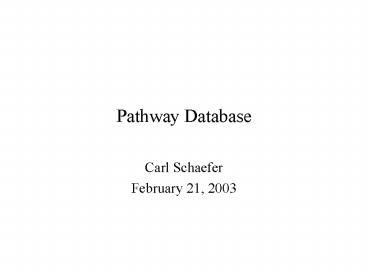Pathway Database - PowerPoint PPT Presentation
1 / 14
Title:
Pathway Database
Description:
Predecessors/Successors. atom-id = 411. direction = forward. degree = 3. prune common compounds ... joins, prunes, finds predecessors/successors. produces graph output ... – PowerPoint PPT presentation
Number of Views:28
Avg rating:3.0/5.0
Title: Pathway Database
1
Pathway Database
- Carl Schaefer
- February 21, 2003
2
Why Spend Effort on Pathways?
- Target as process vs. target as molecule
- In the end, what matters is a hyperactive process
(e.g. mitosis), not just an over-expressed
protein - Phenotype classification
- Higher-level feature than transcript abundance
3
Why Spend Effort on a Pathway Database?
- A picture may be worth a thousand words ...
- but a computable representation is even better
- Make assumptions explicit
- Combine sources of data
- KEGG, BioCarta, ...
- Merge data from separate pathways
- E.g. BioCartas Cyclins and Cell Cycle
Regulation and Cyclin E Destruction Pathway - Causal framework for quantitative
simulation/analysis - ... when the data becomes available
4
Basics
- Model a causal network
- Be composable (novel pathways)
- Cope with lack of knowledge
- Promote understanding
5
Model A Causal Network
- Graph (nodes edges)
- Distinguish two kinds of nodes (molecules
processes) - Allow labels on nodes and edges
- molecule-type (compound, protein, complex, rna)
- molecule-id (...)
- process-type (reaction, binding, modification,
translocation, transcription, cell process) - edge-type (input, output, agent, inhibitor)
- activity-state (active, inactive)
- location (extracellular, transmembrane,
cytoplasm, nucleus) - reversible (yes, no)
6
Composable
- Atomic pathway
- a process node
- immediately adjacent molecules
- the connecting edges
- Join atomic pathways on identical molecules
- ... and maybe on molecule subtype relation
7
Pathway ConstructionJoining Atomic Pathways
8
Lack of Knowledge
- Hierarchy of label values
- e.g., edge-type ? incoming-edge ? agent
- Hierarchy of molecule ids
- GO id
- Gene product
- Specific protein
- Families of molecules
- Handbook
- E.g. for Raf-1, active-1 means
phosphorylation at S259
9
Promote Understanding
- Hide unwanted detail
- prune common molecules
- encapsulate sub-pathways
- Query by connectedness (cause effect)
- Find patterns
10
Omission of Dont Care DetailPruning Common
Compounds
11
Query by ConnectednessPredecessors/Successors
atom-id 411 direction forward degree
3 prune common compounds
12
Patterns
- Templates for atomic pathways
- process-typemodification
- molecule-typeprotein1edge-typeagent
- molecule-typeprotein2edge-typeinputactivity-
stateinactive - molecule-typeprotein2edge-typeoutputactivity
-stateactive - Maybe multi-process templates (e.g., a cascade)
13
What Do We Need?
- Computation model of pathway interactions
- Persistent data model
- Tools
- data input
- query and analysis
- visualization
- Data, data, data, ...
14
What Do We Have?
- Computation model mostly worked out
- Persistent data model mostly worked out
- Tools
- working on data input
- have a query/analysis tool
- joins, prunes, finds predecessors/successors
- produces graph output
- extracts first-order patterns
- using GraphViz to produce SVG diagrams
- Data, data, data ...
- Loaded KEGG into database
- Next 30 BioCarta pathways related to apoptosis,
cell-cycle regulation and histone deacetylase
activity































